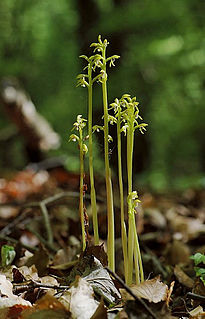
Trillium chloropetalum, also known as giant trillium, giant wakerobin, or common trillium, is a species of flowering plant in the family Melanthiaceae. It is found in the coast ranges of California and the Sierra Nevada foothills, from Siskiyou County to Santa Barbara and Madera Counties.

Filipendula is a genus of 12 species of perennial herbaceous flowering plants in the family Rosaceae, native to the temperate regions of the Northern Hemisphere. Well-known species include meadowsweet and dropwort, both native to Europe, and queen-of-the-forest and queen-of-the-prairie, native to North America.

Corallorhiza trifida, commonly known as early coralroot, northern coralroot, or yellow coralroot, is a coralroot orchid native to North America and Eurasia, with a circumboreal distribution. The species has been reported from the United States, Canada, Russia, China, Japan, Korea, India, Nepal, Kashmir, Greenland, Pakistan, and almost every country in Europe.

Thladiantha dubia, the Manchu tubergourd, goldencreeper, wild potato, or (French) thladianthe douteuse, is a herbaceous perennial climbing vine of the gourd family. It is native to Russia, northern China, and Korea, but has been introduced to Japan, southeast Europe, the Galapagos Islands, and scattered locations in North America. It is occasionally grown as a medicinal plant, or as an ornamental in North America.

Heliopsis is a genus of herbaceous flowering plants in the sunflower family, native to dry prairies in North and South America. The sunflower-like composite flowerheads are usually yellow, up to 8 cm (3 in) in diameter, and are borne in summer. Species are commonly called ox-eye or oxeye.

Helianthus pauciflorus, called the stiff sunflower, is a North American plant species in the sunflower family. It is widespread across the Great Plains, the Rocky Mountains, and the Great Lakes region, and naturalized in scattered locations in the eastern United States and in much of southern Canada.

Carex jamesii, known as James's sedge or grass sedge, is a species of sedge native to North America from Minnesota east to New York and south to Oklahoma and South Carolina. It occurs in mesic hardwood forests and produces fruits from early May to mid July. It has two to four perigynia that are subtended by leaf-like pistillate scales. Its seeds are dispersed by ants.

Eupatorium altissimum, the tall thoroughwort, is a perennial plant whose native range includes much of the eastern and central United States and Canada (Ontario south to Nebraska, eastern Texas, the Florida Panhandle, and Massachusetts. It almost always grows on limestone soils, as does Brickellia eupatorioides, with which it is often confused. It can hybridize with Eupatorium serotinum.

Corylus americana, the American hazelnut or American hazel, is a species of deciduous shrub in the genus Corylus, native to the eastern and central United States and extreme southern parts of eastern and central Canada.

Trillium pusillum is a species of flowering plant in the family Melanthiaceae known by the common names dwarf trillium, least trillium and dwarf wakerobin. It is native to the southeastern and south-central United States from Oklahoma to Maryland.

Eupatorium hyssopifolium, also known as hyssopleaf thoroughwort, is a fall-blooming herbaceous plant native to North America. Like other members of the genus Eupatorium it has inflorescences containing a large number of very small flower heads, each with 5 white disc florets but no ray florets. At 0.5 to one meter tall, it is towards the shorter end of the range of heights found in Eupatorium species.

Abronia mellifera is a species of sand verbena known by the common name white sand verbena.
Brintonia is a monotypic genus of flowering plants in the sunflower family, containing the single species Brintonia discoidea, named for Jeremiah Bernard Brinton. It is known commonly as the rayless mock goldenrod. It is native to the southeastern United States, where it is distributed in Alabama, Florida, Georgia, Louisiana, and Mississippi.

Streptopus is a Eurasian and North American genus of flowering plants in the lily family, found primarily in colder and temperate regions. Members of the genus are often referred to as twistedstalk. It is one of the shade dwelling members of the lily family.

Iris hookeri, commonly called the beach head iris, is a species of Iris.
Rubus setosus, the bristly blackberry, is a North American species of flowering plant in the rose family. It is widespread in much of central and eastern Canada and the northeastern and north-central United States

Carex blanda, the common woodland sedge or eastern woodland sedge, is a sedge native to a wide variety of habitats in the eastern and central United States and Canada.

Petrorhagia saxifraga, known as tunic flower or coat flower, is a small, herbaceous flowering plant in the family Caryophyllaceae. It is native to parts of Europe and introduced to the United States and Canada, Great Britain, and Sweden. Petrorhagia saxifraga is also known as tunic saxifrage, pink saxifrage, or just pink.

Calyptocarpus vialis is a species of flowering plant in the daisy family, Asteraceae. Common names for C. vialis include straggler daisy, horseherb, lawnflower, and creeping Cinderella-weed. It is native to the southern United States, Mexico, Belize, Venezuela, and the Caribbean. It has also been introduced to Argentina, Hawaii, India, Java, Australia, and Taiwan. It is one of only three species in the genus Calyptocarpus.

Pyrularia pubera shrub in the sandalwood family which grows through the eastern United States from New York to Alabama, being mostly found in the Appalachian mountains. It is commonly referred to as buffalo nut. It grows up to 4m tall mostly in the shade of other trees. It is a parasitic plant, specifically a hemiparasite which while still photosynthetic, will also parasitize the roots of other plants around it. It can parasitize many hosts.


















